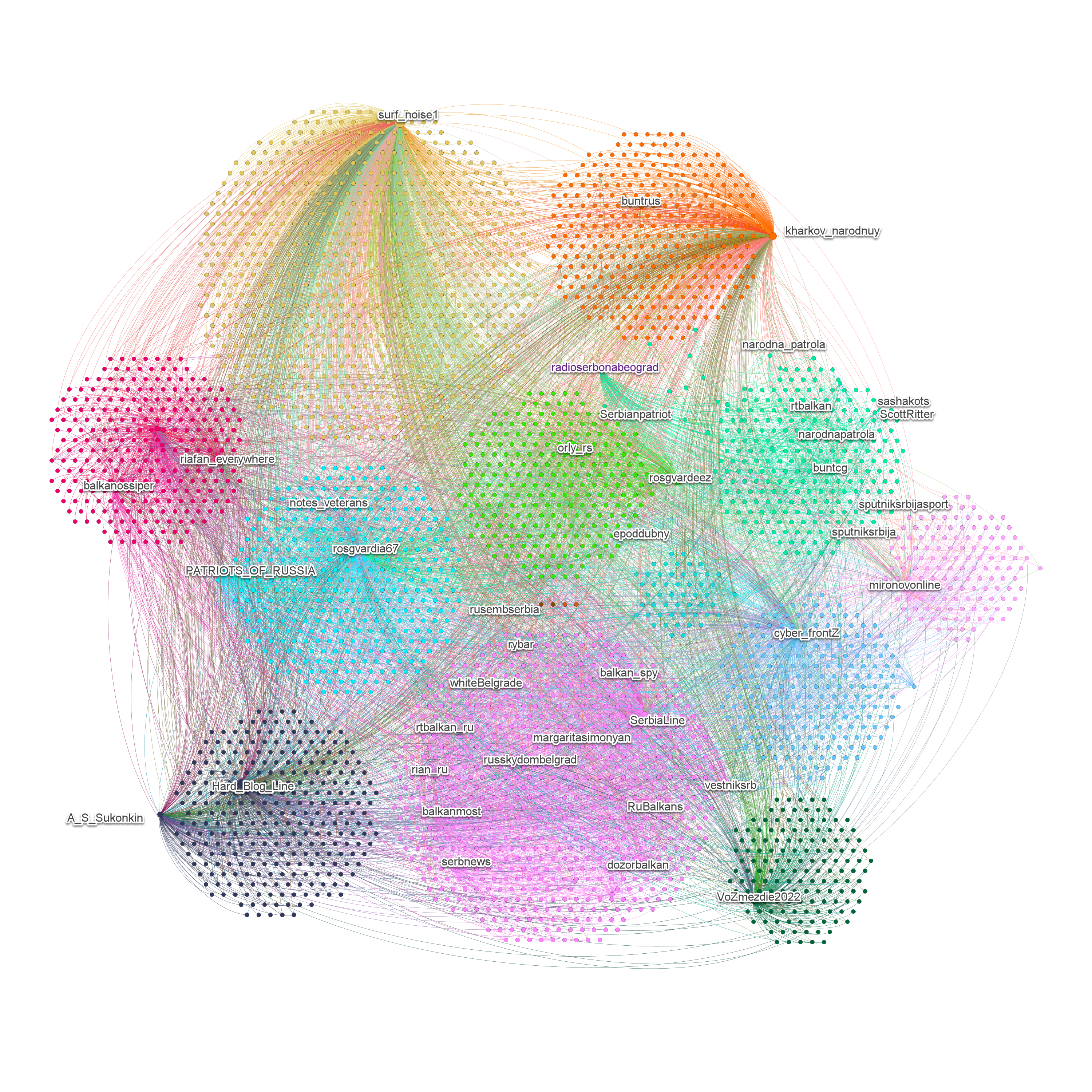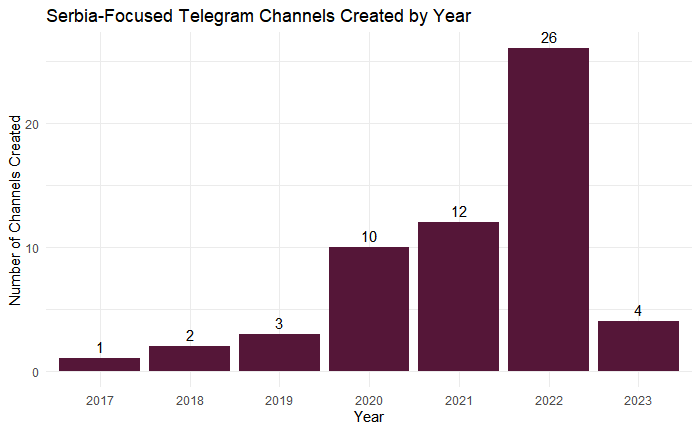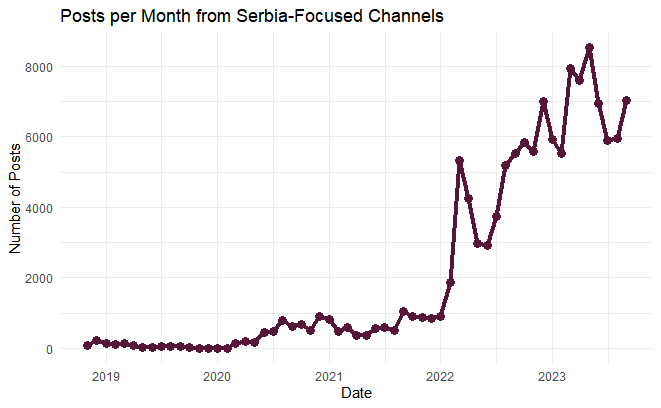The InfoEpi Lab dove into the murky waters of Russia’s influence efforts targeting Serbia.
Serbia in Russia’s Cross-hairs
Since the onset of the renewed conflict in February 2022, Russia has ramped up its efforts, investing more resources, starting new media outlets like the Balkans RT and establishing infrastructure via Telegram bloggers that gives it more influence in Serbia (see Figure 3).
- Some key influencers promoting Russian interests in the Serbian information space appear to have a history of collaborating with media owned by Yevgeny Prigozhin or working for official Russian state media.
- The spike in activity is not exclusive to Serbia–the global digital realm has seen a parallel rise–particularly in the context of the ongoing invasion.
- Serbia’s information space, however, is distinct due to its integration with the broader pro-Kremlin network. The data visualization of message-forwarding showcases the interconnectedness of Serbian channels with the broader pro-Kremlin network.
Even when focusing solely on Serbian-language or Serbia-themed channels, the network’s integration into the pro-Kremlin information ecosystem is evident. Where other surges, like those in Spanish language channels, seem to have waned, the Serbia-related channels remain much more active than before the 2022 invasion (see Figure 5).2
Through these channels Russia can exert influence in the Balkans. Despite some separation between the two communities, specific channels, some of which are the core channels in this report, serve as conduits that forward content into the broader Serbian information ecosystem.
When the network is reduced to channels that appear ten times or more as in Figure 2, the connections between the Russian and the Serbian sides can be seen more clearly. As this is a forwarding network only, this demonstrates the relationships independent of whatever they might share with their audiences.
QAnon (QanonSrbija) references were spotted in the bigger and the smaller forwarding networks. Buntcg, a notably active pro-Kremlin channel, also seems to have disseminated content linked to far-right activist Jack Posobiec.
A blend of channels sharing COVID-19 denial narratives and misinformation regarding vaccines was mixed in with the broader pro-Kremlin information ecosystem. Creation dates for the Serbian-centric channels show a surge in channel creation in 2020, coinciding with the COVID-19 pandemic and another notable increase in 2022.
An Uptick in Activity
Activity, judged in number of posts per day, increased broadly in response to the war, so Serbia’s information space is not unique in that regard. However, the message-forwarding network shows how the pro-Russian Serbian channels are integrated with the broader pro-Kremlin network and how they introduce pro-Kremlin narratives to the Serbian information space.
When restricting the activity to Serbian-language or Serbia-based channels, the difference in activity was more, not less pronounced. This suggests that the activity boost is not from the Russian state media channels alone. While it might have encouraged Serbian channels to be more active, they were posting more frequently, too.
Although there was an increase in the number of channels in 2020, the increase in activity was modest and gradual in comparison to 2022. After the initial invasion, there was a slight dip in activity before it picked up again, ascending to even higher post counts than in February 2022.
A list of channels and data from the study can be found in the full report.
Footnotes
Li, E. R. 2023. “GLOSSARY.” InfoEpi Lab. https://balkans.infoepi.org/glossary. Password:
infoepi↩︎Esteban Ponce de León, “Analyzing the Volume of Kremlin war narratives targeting the Spanish-speaking world,” Digital Forensic Research Lab (DFRLab), November 30, 2022, https://medium.com/dfrlab/analyzing-the-volume-of-kremlin-narratives-targeting-the-spanish-speaking-world-38da532d74ba.↩︎
Citation
@article{li2023,
author = {Li, E. Rosalie},
publisher = {Information Epidemiology Lab},
title = {How {Russia} {Courts} {Serbia} and {Ignites} {Tension} with
{Kosovo}},
journal = {InfoEpi Lab},
date = {2023-10-05},
url = {https://infoepi.org/posts/2023/10/5-balkans.html},
langid = {en}
}





Social Media Powers the Kremlin’s Influence
The results of this study underscored the critical role of social media in Russia’s influence campaigns (see Table 1). The highest-ranking URLs in the study were consistently social media platforms and pro-Kremlin sources like RIAFAN and RT News.
More information about them can be found in the larger report.
80% of the domains in this network appear in just one of the eight datasets, with each dataset representing a channel. That jumps to 96% when considering domains that appear in two or fewer datasets. Fewer than 4% of domains were shared across more than two channels.
Put another way, sources shared across multiple channels were relatively rare. This may make the information delivery vulnerable to disruption.